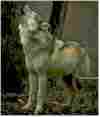
wolves
Wild Animals
alligators
baboons
bears
chimpanzees
crocodiles
deer
dolphins
elephants
foxes
giraffes
gorillas
leopards
lions
seals
sharks
snakes
tigers
whales
wolves
zebras
Pets
dogs
cats
fish
birds
|
This site provides you with the information about wolves, wolf information online, wolf pictures online, wolf photos, wolf pics for kids, images of wolves, wolf description, free wolf info, and more.
If you think that this site is helpful, please recommend your friends to visit our site.
wolves
Wolf, carnivore related to the jackal and domestic dog. All wolves are characterized by powerful teeth, bushy tails, and round pupils. Certain characteristics of the skull distinguish them from domestic dogs, some breeds of which they otherwise resemble.
There are two species of wolves: the gray, or timber, wolf, once widely distributed but now found only in Canada, Alaska, and northern Europe and Russia, except for a few isolated packs in other regions; and the red wolf, found only in Texas and the southeastern United States.
An adult gray wolf measures up to 2 m (6.5 ft) in length, including the tail (less than half the body length), and weighs up to 80 kg (175 lb). The fur of the gray wolf is red-yellow or yellow-gray with black patches on its back and sides, and white on its chest and abdomen. There are also black or brown gray wolves, and those in the far north may be pure white. The red wolf is smaller in size and usually darker in color.
Wolves are equally at home on prairies, in forest lands, and on all but the highest mountains. In the winter they travel in packs searching for food. Small animals and birds are the common prey of wolves, but a pack sometimes attacks reindeer, caribou, sheep, and other large mammals, usually selecting weak, old, or very young animals for easier capture. When no live prey can be found, wolves feed on carrion (decaying flesh of dead animals). They also eat berries.
The den, or lair, of a wolf may be a cave, a hollow tree trunk, a thicket, or a hole in the ground dug by the wolf. In the spring, females have litters of one to eleven pups. Adult wolves sometimes feed young pups by regurgitating partly digested food for them. The pups normally stay with the parents until the following winter but may remain much longer. Parents and young constitute a basic pack, which establishes and defends a territory marked by urine and feces. Larger packs may also assemble, particularly in the winter.
The pack leader is called the alpha male and his mate is the alpha female. As social animals, wolves exhibit behavioral patterns that clearly communicate dominance over or submission to one another. The communal howling of a pack may serve to assemble its members, communicate with other packs, advertise its territorial claims, or it may be simply a way of expressing pleasure. Visual and scent signals are also important in communication.
Although gray wolves are still abundant across northern Europe and Asia, only remnant populations exist elsewhere in Europe. Their numbers in North America also have been greatly diminished. They are fairly abundant only in Alaska and Canada; smaller numbers exist in the Pacific Northwest and upper Midwest, primarily in Minnesota. Under the Endangered Species Act, the gray wolf is listed by the United States Fish and Wildlife Service (USFWS) as threatened in Minnesota and as an endangered species elsewhere in the United States except Alaska. The red wolf, also listed as endangered species, was the first species for which the USFWS developed a recovery plan.
The decreasing numbers of wolves are the result of encroachments on their territory by humans, who have long regarded wolves as competitors for prey and as dangerous to livestock, pets, and people. However, few if any healthy wolves have attacked humans, whom they instead try to avoid.
Wolves are valuable predators in the food web, and their decimation has led to the overpopulation of certain other animal species in various areas.
Active efforts to reintroduce wolves to national parks in the United States are now underway, although such efforts are controversial. Because coyotes have hybridized with some red wolves, an attempt to reintroduce red wolves to parts of North Carolina has involved identifying red wolves that are not part coyote. The success of this project is not yet clear.
In 1995 and 1996 the USFWS reintroduced Canadian gray wolves into Yellowstone National Park and the Sawtooth Mountain region in central Idaho, despite protests from nearby ranchers and some biologists. The reintroduced wolves are producing more offspring than expected. When ten breeding pairs reside in these regions for three years, the gray wolf will be taken off the list of endangered species in the northern Rocky Mountains. Wolf biologists estimate that this goal may be met by the year 2002 without transplanting additional wolves from Canada. By 1997 these reintroduction efforts were succeeding beyond expectations of wolf biologists.
Scientific classification: The wolf belongs to the family Canidae. The gray, or timber, wolf is classified as Canis lupus. The red wolf is classified as Canis rufus.

|